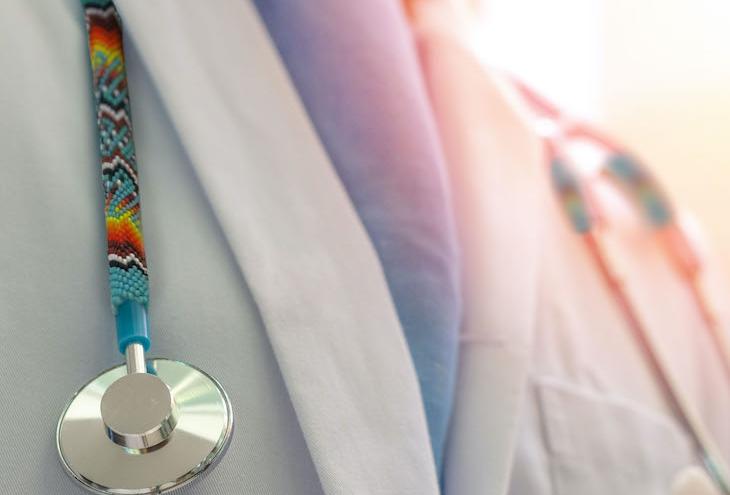As COVID slowly recedes, it’s increasingly clear that health care in Indian Country has been severely stressed. The system had a unique set of challenges before — and during — the crisis, which in many communities has highlighted persistent inequalities resulting from insufficient funding and resources.
In response, the American Rescue Plan passed by Congress in March provides support for pandemic-related health care within tribal communities, including “$2 billion for the broader Indian health care system, which has been hard hit.” In other words, routine checkups and chronic care have been greatly disrupted — an eventuality with important human consequences.
The health care system serving Native people in the U.S. is complex and includes programs managed directly by the Indian Health Service (IHS); tribally run health care programs established through formal agreements with IHS; and services provided by Urban Indian Organizations through grants and contracts with IHS. But as the New York Times noted last September, IHS does not have an emergency office or additional staff to help manage crises such as the pandemic.
Just like every one of the 2.56 million American Indians and Alaska Natives who use this system, each tribe — each Native nation — has its own history and relationship with IHS and health care, and its own experience in the pandemic. Still, a look at the tribal health care system in one community, the St. Regis Mohawk Tribe, can provide a window into the larger situation across Indian Country.
Charting One Community
The Mohawk name for the St. Regis homeland in northern New York State is “Akwesasne.” The larger Mohawk community straddles the St. Lawrence River — and international jurisdictions — and includes the Mohawks of Akwesasne on the Canadian side. The tribe’s response to COVID enlisted cooperation on both sides of the border. Officials from St. Regis disaster preparedness, both communities, local schools, and local health offices met several times during the pandemic to coordinate services.
The St. Regis Tribe itself employs 170 in its health programs, which are tribally run and partially supported by the tribe’s casino. Michael Cook, director of health services for the tribe, recognizes that through the combined efforts of the Akwesasne communities and health care staff, they have been able to avert a dire pandemic outcome. Due in part to their rural location, the impact of the coronavirus was minimal at the beginning, and as safety protocols were put in place, the community followed them. “It involved a lot of education,” Cook says. It also involved research, following the science, and getting information out to staff who were understandably afraid of coming to work.
Some Positive Surprises
For the few staff members, such as in behavioral health, who were approved to work from home, there were some unexpected outcomes. The no-show rate for certain remote appointments dropped to less than 10 percent, from what had been up to 30 percent for the same type of appointment on-site.
And while in-person visits went down drastically, there was another surprising trend: an increase in filling existing prescriptions. “People became more compliant in keeping up on their meds,” Cook says.
Residual Effects
But in-person visits focusing on health maintenance plummeted, and there has been much less contact with chronic-care patients. Along with health professionals across Indian Country, Cook is concerned that overall health for many patients has declined as a result. “Getting people caught up with checks like blood tests has been a challenge,” he says. “A priority is getting back in touch with folks we haven’t had contact with.”
Many tribal health officials share another of Cook’s concerns: addressing burgeoning mental health needs. “Having the staff to meet the uptick in demand for mental health care has been a challenge,” he says. “With our rural location, the number of professionals is not abundant, and the demand has overtasked our current staff.”
Future Strategies
With over 35 years in Indigenous health services, Cook understands that compliance is the primary factor in positive outcomes for chronic care and diabetes management. To meet this ongoing challenge, Cook and his team are looking at more home monitoring systems for elders and those with conditions like heart disease, cancer, and diabetes. Such systems might have made a significant difference for patients who remained isolated during the pandemic. In Cook’s view, being able to care for people in their own home would be the “true telehealth.”
Cook expects some COVID-related limitations on access to health care facilities to continue for at least another year. But getting more people vaccinated could change that predication and normalize community life overall. Vaccination rates in Akwesasne are similar to the rest of the country and, also similarly, demand is now dwindling. To counter that trend the tribe is developing more education resources and may even consider incentives.
Every community is different. But a consideration of St. Regis Mohawk tribal health care paints a picture that turns up widely applicable trends, challenges — and conclusions. Tribal health care has faced tremendous obstacles, and the system, with all its moving parts, has been stretched. To address the health care needs of tribal communities, the system will need greater resources, more proactive planning for emergencies, ongoing education, and more qualified staff members.














